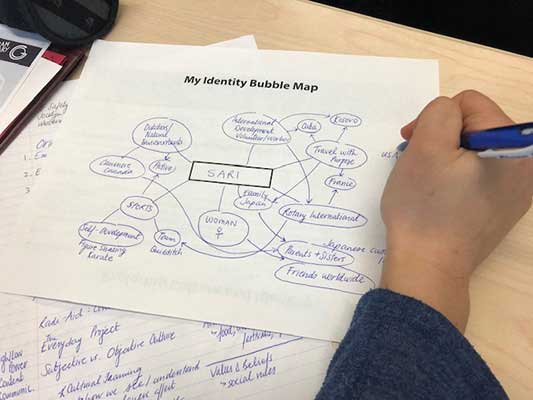
Our contributor Kevin Collins, the Student Development Coordinator at Queen’s, writes about the importance of understanding our own identities in order to learn how to navigate differences respectfully.
This year’s blog theme is unlearning and relearning. My career has given me the opportunity to try my hand at these things. It’s a process that I feel fortunate to have regular opportunities to engage in.
My background is in international and comparative education. Through living and teaching overseas, I’ve been able to see how different educational systems work based on cultural context. As a teacher in South Korea and Sweden, I felt that I was learning about how different educational systems work. What I didn’t realize at the time was that I was viewing things through my own lens based on my culture and identity. When I saw students in Korea attending school on Saturdays, or students in Sweden calling teachers by their first names, I disagreed with these practices because I was used to the schooling model that I grew up with. I didn’t seek to fully understand educational practices from the perspective of the people who were a part of the systems in which I was a visitor. I’ve since been able to reframe my experiences with the knowledge that who I am and my prior lived experiences shape the way that I see the world.
There’s an activity that I often do with students to help frame and personalize this idea: The Bubble Map. I first used the activity when I worked on the Intercultural Learning Program at U of T. In front of the group, I write my name in the centre of a piece of chart paper and then draw circles around it and write in some of the cultural affinity groups that I belong to. Cultural affinity groups include age, race, ethnicity, gender, sexual orientation, socioeconomic status, religion, places you’ve lived, hobbies and interests. I introduce myself to the group and talk about how the cultural affinity groups that I belong to have values, attitudes, norms and practices associated with them. As a gay man who enjoys the outdoors and loves dogs, I really like to go on hikes with my dog and my boyfriend. Someone who is a cat lover, or who prefers city life, might not feel the same way.
I also talk with the group about how the affinity groups that we belong to, or the pieces of our identities, intersect. We can’t say that experiences are the same for everyone in a certain group, because not everyone belongs to the same set of groups. Additionally, some groups we choose to be a part of, and others we are born into. Some parts of who we are are visible, and other parts we can choose to share or not share. There’s a great deal more that could be discussed here related to power and privilege, but the Bubble Map is a nice intro into culture and identity.
After I introduce myself, I ask the students to create their own maps. I let them know that they can include as much or as little as they are comfortable with. They then introduce themselves to each other. The conversations that I hear are amazing:
Someone with one parent and another with four parents talking about what family life was like growing up
A Kingstonian sharing how Toronto feels too busy with a person from Shanghai who thinks that Toronto is fairly quiet and small compared to what they are used to
A piano player and a sailor comparing and contrasting the values, beliefs, norms and practices associated with their hobbies
How does all of this relate to unlearning and relearning? I think that we often make assumptions about things based on who we are and our lived experiences. By examining how culture and identity impact our perceptions it allows us to think reflexively. Additionally, by opening ourselves up to hear from others who are different from us, we can better understand them and the way that they see the world. Doing so can change our thinking, making us more empathetic. Learning how to navigate differences respectfully is key in fostering a more inclusive campus.